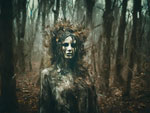What is AI Data-Driven Art?
AI Data-Driven Art refers to the creation of artworks that are fundamentally based on the analysis and utilization of data, with artificial intelligence playing a crucial role in the interpretation, manipulation, and visualization of this data.


This form of art leverages large datasets, algorithms, and computational techniques to generate creative pieces that often reveal patterns, insights, or aesthetic qualities embedded within the data. Here are some key characteristics and aspects of AI Data-Driven Art:


Data as a Medium: In AI Data-Driven Art, data itself is the primary material. This data can come from various sources, such as social media, scientific research, environmental sensors, or personal records.


Algorithmic Interpretation: AI algorithms, especially those based on machine learning and deep learning, are used to interpret and process the data. This can involve identifying patterns, correlations, or anomalies that can then be translated into artistic expressions.


Visualization and Representation: The processed data is often visualized in innovative ways, turning abstract numbers into compelling visual art, dynamic installations, or even interactive experiences.


Generative Processes: AI can generate new data or transform existing data into novel artistic forms. This generative process can produce unique pieces each time it runs, based on the input data and algorithmic rules.
Dynamic and Interactive Art: Some AI Data-Driven Art is designed to be dynamic and interactive, changing in real-time based on incoming data streams or user interactions.
Exploration of Themes: This form of art can explore complex themes such as data privacy, surveillance, the impact of technology on society, environmental issues, or the beauty of mathematical structures.
Collaboration Between Artists and Data Scientists: Creating AI Data-Driven Art often involves collaboration between artists, data scientists, and technologists to effectively merge artistic vision with technical expertise.
Examples and Applications: Examples include data-driven installations that visualize climate change data, generative music compositions based on social media trends, and digital sculptures created from biometric data.
Tools and Platforms: There are specialized tools and platforms that facilitate the creation of AI Data-Driven Art, such as programming environments (e.g., Python, Processing), machine learning frameworks (e.g., TensorFlow, PyTorch), and data visualization libraries (e.g., D3.js, Plotly).
In essence, AI Data-Driven Art is an interdisciplinary field that merges the precision of data science with the expressive potential of art, creating works that are both intellectually stimulating and aesthetically engaging.
Cloud: Data Visualization, Algorithmic Art, Machine Learning, Deep Learning, Generative Art, Big Data, Data Aesthetics, Computational Art, Interactive Art, Real-Time Data, Art and Technology, Data Interpretation, Digital Art, Data Sonification, Artificial Intelligence, Dynamic Art, Biometric Art, Data Science, Generative Algorithms, Creative Data Analysis